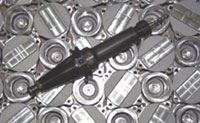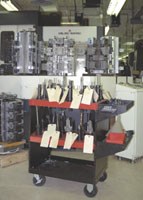Boosting Machine Output While Using Fewer Toolholders
Toolholder distortion can impede machining operations, especially if the toolholder walls collapse during high speed operation. All sorts of problems can result, from cutting tool breakage and loss of the machined parts to costly damage of the machine spindle and drawbar.
Share



Hwacheon Machinery America, Inc.
Featured Content
View More

.png;maxWidth=45)
DMG MORI - Cincinnati
Featured Content
View More
ECi Software Solutions, Inc.
Featured Content
View More




Autodesk, Inc.
Featured Content
View MoreToolholder distortion can impede machining operations, especially if the toolholder walls collapse during high speed operation. All sorts of problems can result, from cutting tool breakage and loss of the machined parts to costly damage of the machine spindle and drawbar.
Machinists take precautions because multi-axis machining centers are costly, and downtime can determine profit or loss. Just as important, today's continuous improvement programs mandate heading off problems like these before they happen.
Changing toolholder brands and using hydraulic grip toolholders in combination with other specialty toolholders can solve rigidity requirements while improving quality and increasing productivity. This was the case at Ross Controls of Madison Heights, Michigan, when it did an analysis of its toolholder performance and usage.
Ross Controls, a manufacturer of compressed air control valves, is credited with developing the first pneumatic control valve in 1920. Today the company manufactures a broad line of base and line mounted valves, check and flow valves, and electropneumatic control networks. All of these products require precision components machined from 6061 die cast aluminum, sand castings and aluminum bar stock.
To drill, tap, bore and finish these parts, Ross Controls utilizes an A55 and an A55 Plus Makino machining center. The company was contemplating purchase of an A55 Delta, known for its high speed; the latest models have from 50 to 14,000 rpm in 2.0 seconds to max rpm, 0.1g to 0.5g feedrates, and thermal control to handle the heat of high spindle speeds.
On its valve body assemblies, Ross Controls does a great deal of small hole drilling using 0.031 - 0.020 inch diameter drills at depths up to 8 inches. Some of the valve bodies are under an inch square and weigh just ounces, while the largest measure more than 2 square feet and weigh up to 35 pounds. Part runs vary, as does the amount of metal removal required, which depends on the size and configuration of the part.
Using standard shell mill and end mill holders to get needed tool rigidity in the cut, machine operators tightened these toolholders to the maximum. They discovered that while in the setup rack prior to use, some of the toolholder shanks cracked open from the tightening torque and had to be replaced.
Contemplating purchase of its third Makino machining center, an A55 Delta with even more high performance features than its two A55's, Ross Controls did further analysis of toolholder performance and usage prior to expanding its machining department with new equipment.
"Our operators began to really test the toolholders' strength and ability to handle the needed tightening pressure for ample toolholder rigidity to match the output speeds of our two A55 machines," says Greg Looper, Ross Controls programmer and production operator. "But it was evident they just weren't meeting our production requirements. You could hear holders ‘pop' when in the rack. The cracking sound surprised us because we hadn't experienced anything like that before. We didn't want to acquire a new machine with higher performance features until we were assured the toolholders would work. Upon further inspection of the toolholders, we found several that cracked and were no longer serviceable and had to be trashed. In all, we ended up purging 65 toolholders from our inventory that failed to perform up to our needs. We were at an impasse with our toolholder inventory because we had to have concentricity of ±0.0005 inch on many of the larger holes and ±0.0001 inch on the most critical small holes."
Mr. Looper called in Alan Novack, Command Tooling Systems sales representative, for recommendations on solving the problem. Mr. Novack suggested a test of Command's Hydraulic Grip toolholders, which are designed to provide high gripping pressure around cutter shanks for high precision centerline accuracy.
With Command Hydraulic toolholders, no axial movement of the tool can take place to upset tool length settings. This is due to the 360-degree uniform pressure, which clamps the tools concentrically with uniform contact achieved over the full length of engagement. This gives the holder a high degree of concentricity resulting in high repeatability, exactly what Ross Controls needed to hold its small hole tolerances of ±0.0001 inch. The company sought true tool performance and no toolholder failure because of tightening torque problems.
Ross Controls went ahead with the purchase of the A55 Delta machine and installed a full 137-tool magazine of Command Hydraulic, Micro Precision and standard end mill toolholders in it. The machine has two rotating tables, and each was equipped with four-sided tombstones. The eight-pallet machine, equipped with the new toolholders, delivered up to 130 percent improved efficiency compared to the previous setup.
Mr. Looper explains that each product run on the machining centers has its own efficiency standard. Different products are run on the same machine at the same time, which requires a great deal of machining flexibility in the production cycle. With the toolholder upgrades, these efficiencies improved significantly across the board up to 130 percent. He also pointed out that unattended run time was improved.
Included in the tooling package were center drills and form tools, in addition to standard end mills and shell mills. A production savings occurred with the form tools usage, some of which cost $2,000 to $3,000 each. Mr. Looper says that by using the form tools in the new Command Hydraulic toolholders with the added gripping power and extra concentricity, machine operators were able to take full advantage of the new machine's faster acceleration/deceleration speeds up to 14,000 rpm in just 2 seconds, and the faster feed rates (up to 80,000 mm/min. rapid traverse from the new A55 Delta Makino). "We were able to take more aggressive cuts and get greater productivity in less time than before. We also didn't have to stop the machine and remove toolholders for tool sharpening as often."
In the newly acquired Command Hydraulic tool inventory, Ross Controls used Command's CAT 40 taper holders. Also included were extended length holders for the deeper hole making requirements.
For its more difficult boring operations with its Makino machines, Ross Controls installed Command's Urma Modular Boring tools. These are used to bore up to 3-inch diameter by 7-inch deep holes on the larger control valve bodies. Mr. Looper says that he uses the Urma Versa Max boring system for both the roughing and finish bore operations with good results. All of the finished bored surfaces are "rolled" using a burnishing tool in a Command Hydraulic toolholder to meet part finish requirements.
Mr. Looper said his company was able to reduce its required toolholder inventory even with the additional Makino machine because of better overall performance with the new Command toolholders. "We're getting three to four times the toolholder life now with Command, and we're doing it with higher quality and less scrapping out of parts. And while the new Command toolholders cost more, our overall tool expenditures are close to half than that previously because of the greatly improved performance."
Related Content
How to Accelerate Robotic Deburring & Automated Material Removal
Pairing automation with air-driven motors that push cutting tool speeds up to 65,000 RPM with no duty cycle can dramatically improve throughput and improve finishing.
Read MoreRead Next
Registration Now Open for the Precision Machining Technology Show (PMTS) 2025
The precision machining industry’s premier event returns to Cleveland, OH, April 1-3.
Read MoreSetting Up the Building Blocks for a Digital Factory
Woodward Inc. spent over a year developing an API to connect machines to its digital factory. Caron Engineering’s MiConnect has cut most of this process while also granting the shop greater access to machine information.
Read MoreBuilding Out a Foundation for Student Machinists
Autodesk and Haas have teamed up to produce an introductory course for students that covers the basics of CAD, CAM and CNC while providing them with a portfolio part.
Read More































.png;maxWidth=300;quality=90)















